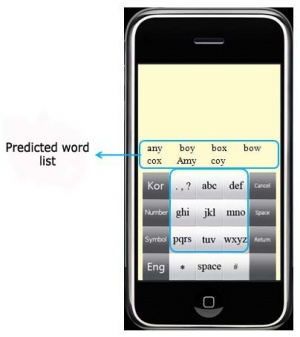

With these keypads, cell phone consumers may one day marvel at how quickly their fingers can type away on the keypads.
Park and Roh founded faster ways to enhance keypad typing for four different languages—Korean, Chinese, English, and Hindi. “As these four languages are listed as some of the world’s most popular languages, it only made sense to go ahead of our time, awaiting the day when such languages as Chinese and Hindi will be widely used,” Park explained.
The two developed the word, Hanal Narat-geul, from a play on words on Han-geul. Hanal is derived from the Korean definition of ‘vowel,’ and Narat-geul is derived from the Korean definition of ‘consonant,’ which they themselves put together.
In the case of the average Korean keypad, the consonants are usually separated from the vowels on each key. Originally, two vowels are incorporated into a single keypad. However, from Hanal Narat-geul, in just one pad, they were able to incorporate more vowels. In doing so, keypad typing became faster and a lot more efficient.
Essentially, the number of vowels and consonants for the fingers to handle is semantically reduced. In other words, the professors were able to combine some parts of any Ko-rean letter together, in that ‘word typing’ can take as short as a few milli-seconds. For example, though it took six taps to construct a word like ‘us,’ it now takes just three or four with Hanal Narat-geul.
The changes that Park and Roh have taken in the case of the English keypad are different. It is important to first understand the current standard methods of cellular phone typing. There is the multi-tapping system, in which the user taps multiple times on different keys to construct a word—today’s most popularly used keypad typing technique; and there is the ‘T-9 system,’ or word-prediction system, in which the phone predicts what word the user wishes to type in half the time it takes for the multi-tapping system. For instance, as de-monstrated on Figure 1, to type in ‘boy,’ the user must tap buttons 2, 6, and 9 once each, and the device provides a list of words it assumes we wish to type.
Park and his colleague named their enhanced typing system ‘Hanal-geul T9.’ In the case of the T9 system, the predicted word list is separate from the keypads. For the Hanal-geul T9, the list is embedded into each key that time to look back and forth from the keys to the list is eliminated. As seen in Figure 2, the 5 key is replaced with a ‘Hanal’ key; as users type in a word, by pressing the Hanal key, the predicted word list appears above each key, in which users can immediately pick the word of their choosing—note that the word list appears on top of the buttons, not on the screen above keypad. In doing so, users do not have to waste time rotating their eyes up and down the screen and the keys to check for mistakes, etc. Once the word list pops up, users can easily tap within a millimeter reach to the desired key or word. With the Hanal-geul T9, typing time is reduced by half, and the screen will be no longer covered by the word list and fingers originally covering half of the screen.
In today’s modern society, it is in with touch phones and out with plastic regular ‘button’ phones. As of now, only touch phone users will have access to the Hanal-geul keypad. Since the keypad itself is on the screen, touch phone users need only download it, converting their current keypad to Hanal-geul’s.
It is hard to say when Hanal Narat-geul shall be open to users any time soon yet. “We haven’t gotten to consumer testing yet, which won’t be until after the media buzz about our discovery,” Park said

